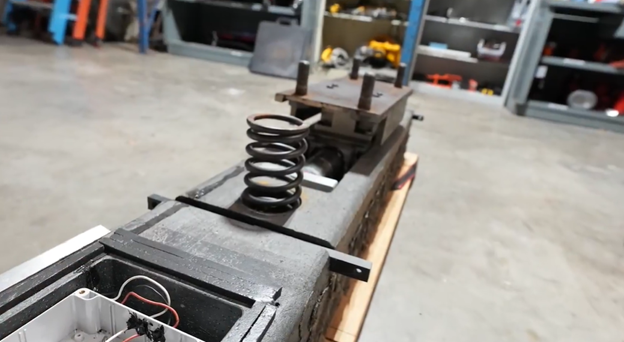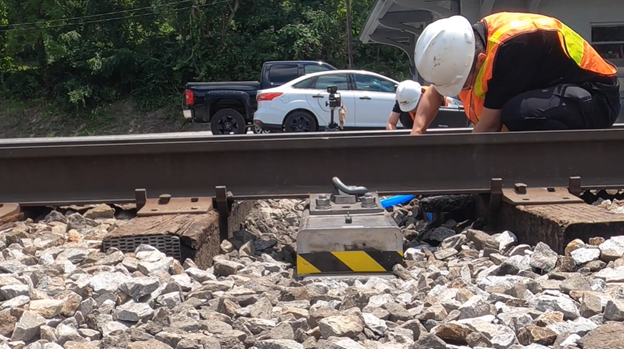Rectangular railroad ties (also called crossties) serve an important role in the function of rail transportation without incorporating advanced technologies. That may change due to ongoing research from the Railway Technology Laboratory at Virginia Tech’s Center for Vehicle Systems and Safety (CVeSS). Their smart tie concept, seen in Figure 26, places a generator inside of the tie, the weight of a passing train turning its internal gears and producing electricity. This track harvester is distinct from previous concepts for using only downward motion, which its creators note as simplifying installation and increasing reliability.[i] Its creation was enabled by U.S. DOT funding through the Virginia Tech University Transportation Center.

An example of machinery incorporated into the smart ties to generate electricity from the movement of a passing train. Source: Virginia Tech Center for Vehicle Systems and Safety, 2023
Project Purpose
With each axle or wheelset passing over the current iteration of the generator producing in the range 5 to 10 W, the passage of a train with tens or hundreds of cars could see the device harvest kilowatts of power, particularly on high-traffic lines or areas where multiple devices are installed.[ii] This power can be stored in batteries for use by trackside smart equipment, supporting efforts to improve safety and efficiency through technology.
The potential benefits of this method of generation are greatest in rural America. The Federal Railroad Administration reports that nearly three quarters of track is in rural areas.[iii] Harvested electricity allows greater use of technology in remote areas which may lack convenient power infrastructure to rely upon—with one application being to power Many existing systems rely on either solar panels, which can be damaged, stolen, or rendered useless by lack of sunlight; or propane-powered generators, which require their own service and fuel replenishment.[iv] A track harvester draws power from the motion of a train, which will otherwise go to waste as the train continues onward. This power can be applied to new ITS tools such as sensors—temperature, humidity, accelerometer, acoustic, LIDAR, radar, or others—that flag potential hazards and monitor train and track condition.[v]
Outcomes
The idea for the track harvester began as a generator built into an electrical damper, tested at the U.S. DOT’s Transportation Technology Center (TTC) test facility in Pueblo, Colorado. The idea was found workable but its overall harvested energy too small, which led the researchers turning their focus to the track and its potential to safely house otherwise delicate equipment. Over a two-year period, the smart tie was conceived, a prototype was produced and tested in the Railway Technology Laboratory, that prototype was improved, and it began its current testing in collaboration with Norfolk Southern—a Class I railroad—on their revenue-service track.[vi]
Private parties doing business in rail or in tie manufacturing have reportedly expressed enthusiasm for the smart tie concept, recognizing the potential benefit of generating electricity from a process that their work already interfaces with regularly.[vii] Rural regions seeking to improve safety with technologies deployed in urbanized areas will benefit from additional power reducing costs or allowing additional hardware to be deployed.
As a prototype undergoing testing, the current smart tie design has recently undergone design improvements based on the lessons learned while testing. With confidence expressed in future improvements as the testing process continues, the harvesting potential of this technology could increase meaningfully, strengthening the incentive for future adoption while planning new track infrastructure or performing upkeep on existing track.[viii] Like many largely novel technologies, increased awareness of its utility will translate into more minds and resources seeking to improve upon the design. Potentially 4,000 Watts per train per device is not insubstantial and may be a milestone before even greater harvest potential.
Resources
A notable benefit to the smart tie is that its installation process is currently as simple as standard tie installation, as seen below. CVeSS noted that the railroad crew installing the test tie were seeing it for the first time, yet crew members were able to install it in a similar length of time to one without an energy harvester.[ix] The smart tie takes up no more space than a standard tie, and the durable substance of the tie avoids the need for regular maintenance on the internal components.

Workers install the smart tie on the track for testing. Source: Virginia Tech Center for Vehicle Systems and Safety, 2023
Where more consideration may be necessary is for the generated electricity once it has left the harvester. Wires from the smart tie will connect to some manner of battery bank or energy storage device, the specifics of which will likely depend on each rail operator and the smart equipment they wish to operate trackside. Any battery bank or other linked components will benefit from being installed either between the tracks or some distance from them so as to avoid serious damage, this being the greatest change from what conventionally exists on a railroad track.[x] Such installations may require their own expertise and upkeep, beyond the costs of smart ties intended to ultimately save more money than they cost.
For more information, visit the CVeSS website at https://cvess.me.vt.edu.
[i] Pan, Y., Zuo, L., Ahmadian, M. (2020). “Design and Bench Tests of a Smart Railroad Tie for Energy Harvesting.” Proceedings of the 2020 Joint Rail Conference, St. Louis, Mo, April 20 – 21, 2020. https://doi.org/10.1115/JRC2020-8133
[ii] Personal communication with Dr. Mehdi Ahmadian, February 2023
[iii] United States Department of Transportation, Federal Railroad Administration. https://railroads.dot.gov/rural
[iv] Personal communication with Dr. Mehdi Ahmadian, February 2023
[v] Institution of Mechanical Engineers. (2021). “Energy harvesting powered rail track sensor technology is becoming a reality.” https://www.imeche.org/news/news-article/energy-harvesting-powered-rail-track-sensor-technology-is-becoming-a-reality
[vi] Personal communication with Dr. Mehdi Ahmadian, February 2023
[vii] Personal communication with Dr. Mehdi Ahmadian, February 2023
[viii] Personal communication with Dr. Mehdi Ahmadian, February 2023
[ix] Personal communication with Dr. Mehdi Ahmadian, February 2023
[x] Personal communication with Dr. Mehdi Ahmadian, February 2023
This report was delivered to the U.S. Department of Transportation in 2023. It was primarily authored by NADO Associate Director Carrie Kissel and NADO Research Fellow Danny Tomares. Many transportation agency staff and others assisted with this project in a variety of ways. We offer deep and heartfelt thanks to all the individuals who have provided information and images, consented to be interviewed, and offered editorial guidance in support of this research. Any opinions, findings and conclusions, or recommendations expressed in this publication are those of the authors and do not necessarily reflect the views of U.S. DOT or the NADO Research Foundation.
To read more about the NADO Research Foundation’s ITS case studies, follow this link.


